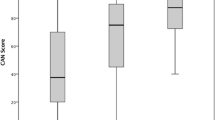Abstract
Objective
To establish the diagnostic quantitative criteria for fire-heat syndrome (FHS) of Chinese medicine (CM) based on the receiver operating characteristic (ROC) curve and principal component analysis (PCA).
Methods
The symptoms and signs of FHS cases and healthy subjects from Guangzhou, Henan and Hunan of China were collected through questionnaire, and the diagnostic quantitative score tables were established for the three regions, respectively, with the method of maximum likelihood analysis. The homogeneity test was then performed on the diagnostic score tables for the three regions with ROC curve, and the diagnostic efficiency of diagnostic score tables for the three regions was compared with the prospective test and retrospective test. The method of PCA was adopted to obtain the analysis matrix for classifying the tapes of FHS.
Results
Twenty-seven elements of FHS were confirmed through Chi-square test, and the diagnostic score tables for the three regions were established with the method of maximum likelihood analysis on the basis of the collected case data. According to the ROC curve test, the areas under ROC curve of Guangzhou diagnostic score table assessment with candidates in Guangzhou, Henan and Hunan were 0.998, 0.961 and 0.956, respectively. It showed that the diagnostic efficiency of Guangzhou diagnostic score tables was the highest one. With the prospective test, the area under ROC of Guangzhou diagnostic score table was 0.949, and more than any other diagnostic score table. By PCA, FHS was classified into excess fire and deficiency fire, and then classified into syndrome of flaring up of Heart (Xin) fire, syndrome of Lung (Fei)-Stomach (Wei) excess fire, syndrome of deficiency of Liver (Gan)-yin and Kidney (Shen)-yin, and syndrome of deficiency of Lung-yin from the view of viscera. In the retrospective test, the consistency with clinicians' diagnosis was 69.4%, and in the prospective test, it was 70.1%.
Conclusions
The Guangzhou diagnostic score table could be used as the recommended criteria for the diagnosis of FHS. The classification of FHS was basically in conformity with the clinical situation.
Similar content being viewed by others
References
Ge N, Gong J, Ni SF, Luo RF, Zhao T, Lu F, et al. Excessive heat, infl ammatory and the relationship with free radicals. J Liaoning Univ Tradit Chin Med (Chin) 2011;13:87–89.
Xie ZJ, Wang WJ. Preliminary exploration of pathogenic factors and pathogenesis of excessive internal heat. J Zhejiang Univ Tradit Chin Med (Chin) 2013;37:226–228.
State Bureau of Technical Supervision. GB/T 16751. 2-1997. Clinic terminology of traditional Chinese medical diagnosis and treatment—syndromes. Beijing: Standards Press of China;1997:2,7,13.
Luo TL, Chen GL, Zhao YQ, Chen ZQ, Shi LJ, Zhao JF. Quantitative differential diagnosis and clinical evaluation of fi ve Chinese medical syndromes of Liver diseases. China J Modern Med (Chin) 1999;9:29–30.
Zhao H, Wang SX, Li XH, Chen JX. Development and evaluation of Chinese medicine fi re-heat syndrome scale in oral cavity for measuring Chinese herb toothpaste. Chin J Integr Med 2013;19:192–199.
Jiang J. General situation of Chinese medicine symptom quantization diagnostic criteria research method. J Chin Med (Chin) 2010;25:94–96.
Zhou YD, Song J, Zhao YH. Local polynomial fitting of receiver operating characteristic curves. J Sichuan Univ (Natur Sci ed, Chin) 2007;44:933–938.
Wu DR, Lai SL, Guo XF, Wen ZH, Liang WX. Reliability and validity of health scale of traditional Chinese medicine. J Chin Integr Med 2008;6:682–689.
Xie L, Wang Z. Correlation between echocardiographic left ventricular mass index and electrocardiographic variables used in left ventricular hypertrophy criteria in Chinese hypertensive patients. Hellenic J Cardiol 2010;51:391–401.
Soo OY, Lim LH. A description of two new species of Ligophorus Euzet & Suriano (Monogenea: Ancyrocephalidae) from Malaysian mugilid fish using principal component analysis and numerical taxonomy. J Helminthol 2013;22:1–19.
Author information
Authors and Affiliations
Corresponding author
Additional information
Supported by the National Natural Science Foundation of China (No. 81273817) and the Program of Guangdong Province Administration of Traditional Chinese Medicine (No. 20121225)
Rights and permissions
About this article
Cite this article
Liu, Sj., Huang, Zs., Wu, Qg. et al. Study on diagnosis criteria of fire-heat syndrome based on receiver operating characteristic curve and principal component analysis. Chin. J. Integr. Med. 22, 258–266 (2016). https://doi.org/10.1007/s11655-014-1897-0
Received:
Published:
Issue Date:
DOI: https://doi.org/10.1007/s11655-014-1897-0




